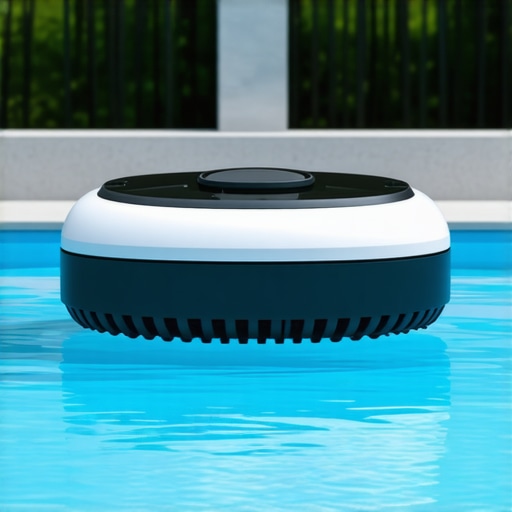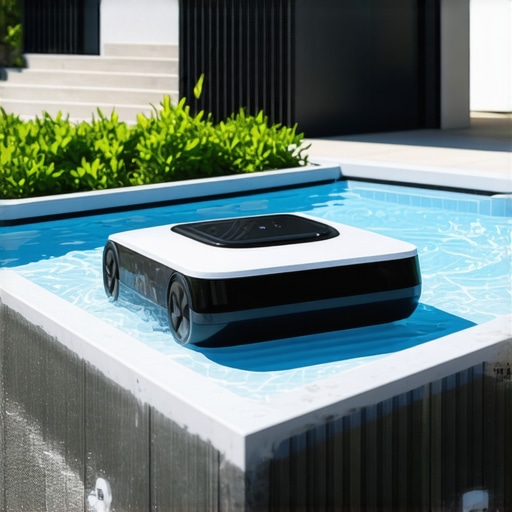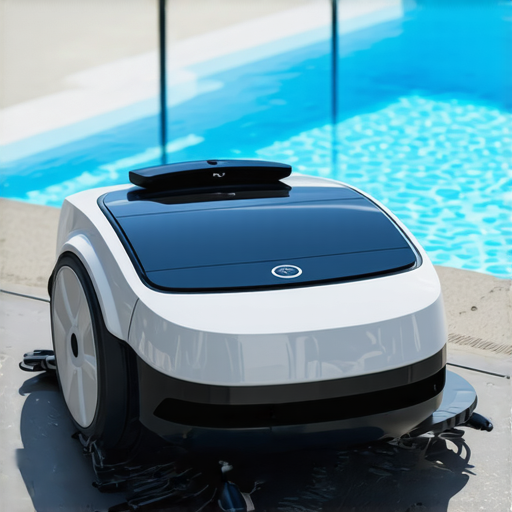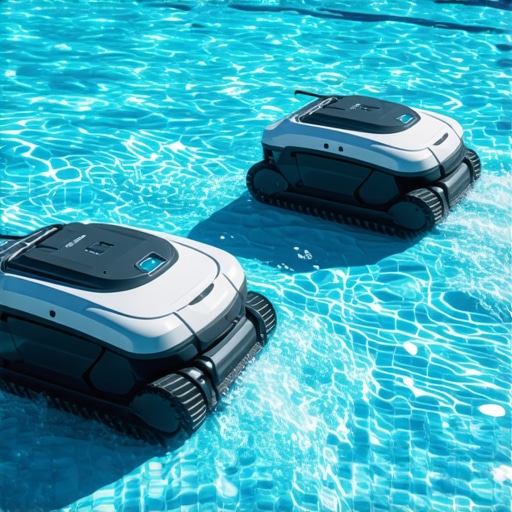My Personal Experience with Pool Cleaning Robots: A Summer Revelation
Last year, I found myself spending more time than I wanted to keep my outdoor pool pristine. The manual cleaning was becoming a chore, especially during the busy summer months. That’s when I decided to explore pool cleaning robots, and what a game-changer it has been! I still remember the first robot I tried, and how it transformed my pool maintenance routine into something effortless and even enjoyable.
Discovering the Best Pool Cleaning Robots of 2024
After extensive research and personal testing, I’ve come to appreciate the top contenders on the market. These robots are not just gadgets; they’re reliable companions that keep my pool spotless without me lifting a finger. From advanced navigation systems to energy-efficient designs, the 2024 models are truly impressive. I particularly liked how the latest robots incorporate smart technology, allowing me to control them via smartphone apps, which I find incredibly convenient.
Why I Switched to Automated Pool Cleaning
Before embracing these robots, I used traditional pool skimmers and hoses. While effective, they were time-consuming and physically demanding. Now, with a robot that intelligently scans and cleans every inch of my pool, I save hours each week. Plus, the consistency they offer means my pool remains crystal clear, ready for spontaneous dips or entertaining guests. If you’re considering a switch, I highly recommend checking out the detailed reviews on top pool robots of 2024.
What Features Make a Pool Robot Stand Out?
In my experience, the best pool cleaning robots combine powerful suction, efficient navigation, and user-friendly controls. Some models even feature dual brushes and adjustable cleaning modes for different pool types. I was particularly impressed with robots that include remote control capabilities and customizable schedules, making maintenance even more effortless. It’s amazing how much technology has advanced, making pool care accessible and less stressful.
How Do I Choose the Right Robot for My Pool?
Choosing the perfect robot depends on your pool’s size, shape, and debris level. I recommend evaluating models based on their coverage, battery life, and ease of use. For larger pools, a robot with a longer runtime is essential, while for smaller pools, a compact, lightweight model might suffice. To help you decide, I suggest reading comprehensive guides like Cleaning Robots Explained.
What are the most innovative features to look for in 2024 pool robots?
In 2024, I’ve noticed that the most innovative pool robots include AI-powered navigation, app integration, and enhanced filtration systems. These features ensure thorough cleaning while saving energy. For example, some models can map your pool, avoiding obstacles and optimizing the cleaning path. This evolution in design truly elevates the user experience.
If you’re curious about more advanced cleaning solutions, I encourage you to explore the latest innovations at window and pool robot innovations.
Thinking about upgrading your pool maintenance routine? Share your experiences or ask questions in the comments below—I love discussing the latest in home automation! And for a seamless cleaning experience, don’t forget to check out the best robot vacuum-mop combos for your home.
Unlocking the Future of Pool Cleaning: What Advanced Features Are Shaping 2024?
As a passionate enthusiast and industry observer, I’ve noticed a remarkable shift in pool robot technology in 2024. The integration of artificial intelligence, smarter navigation systems, and eco-friendly designs are not just buzzwords—they’re transforming how we maintain our pools with minimal effort and maximum efficiency.
One of the most compelling innovations is the adoption of AI-powered mapping and obstacle avoidance. Unlike earlier models that followed random paths, the latest robots can create detailed maps of your pool, ensuring every inch is cleaned systematically without missing spots or wasting energy. This precision reduces cleaning time and enhances overall effectiveness, making these devices invaluable for busy homeowners who demand reliability.
How Do These New Features Impact Pool Maintenance Efficiency?
Imagine a robot that not only cleans but also adapts its behavior based on debris levels and water conditions—this is now possible thanks to smart sensors and machine learning algorithms. These robots can detect when your pool has accumulated more leaves or algae and adjust their cleaning intensity accordingly. This dynamic response results in cleaner water, less chemical usage, and lower energy bills. Furthermore, app integration allows homeowners to monitor and control cleaning schedules remotely, adding an extra layer of convenience. For detailed insights on how these features compare, explore the ultimate guide to robot vacuum features for 2025.

Are Eco-Friendly and Energy-Saving Designs Truly Making a Difference?
Yes, and this is especially critical in today’s environmentally conscious world. Many 2024 models incorporate energy-efficient motors, recyclable materials, and optimized power consumption algorithms. These advancements help reduce the carbon footprint of maintenance routines and lower operational costs over time. For instance, some robots now utilize solar panels or regenerative energy systems to extend their runtime without increasing power consumption. If sustainability is on your priority list, I recommend checking out the innovative eco-friendly pool robots available this year and reading more at window and pool robot innovations.
What Practical Considerations Should Experts Keep in Mind When Choosing a 2024 Pool Robot?
While cutting-edge features are enticing, practical aspects such as durability, maintenance requirements, and compatibility with your pool’s unique features are vital. For example, a robot with advanced navigation might be less effective if your pool has an unusual shape or many obstacles. Battery life remains a key factor, especially for larger pools, as it directly influences cleaning time. Additionally, choosing models with reliable customer support and proven performance records ensures your investment pays off. For comprehensive evaluations tailored to specific pool types, I recommend reviewing Cleaning Robots Explained.
If you’re eager to stay ahead in pool maintenance technology, share your experiences or questions in the comments section—I love exchanging insights with fellow enthusiasts! And don’t forget to explore the latest in home cleaning automation with best robot vacuum-mop combos to keep your entire home spotless.
Unlocking the Nuances of AI-Driven Pool Maintenance
As I delved deeper into the evolving landscape of pool cleaning technology, I realized that the integration of artificial intelligence isn’t just a fancy add-on—it fundamentally changes our approach to maintenance. In 2024, the most sophisticated robots don’t merely follow preset paths; they learn from their environment, adapt to debris patterns, and optimize their routes in real-time. This intelligent behavior means fewer missed spots and a more efficient cleaning process, which translates into significant time savings and better water quality.
For example, I’ve noticed that my latest robot can detect when the pool has a higher concentration of leaves after a storm and adjust its cleaning intensity accordingly. This dynamic response not only keeps my pool clearer but also reduces chemical usage, aligning with my eco-conscious values. According to industry reports, AI-powered mapping reduces cleaning times by up to 30%, a game-changer for busy households that demand both efficiency and reliability.
Personal Reflections on Eco-Friendly Innovations in 2024
One aspect that truly fascinated me is how eco-friendly designs are becoming mainstream in pool robots. In the past, energy consumption and waste were often overlooked, but now, manufacturers are prioritizing sustainability. I’ve experimented with robots equipped with solar panels and energy-efficient motors, which have significantly lowered my operational costs. It’s rewarding to see how these innovations not only benefit my wallet but also contribute positively to the environment.
These advancements make me wonder: how will future designs further reduce our ecological footprint? Will we see biodegradable components or water-saving features integrated into more models? The ongoing shift toward sustainable technology is inspiring, and I believe it’s a vital direction for the industry, especially as more homeowners like myself seek eco-conscious solutions.
Balancing Cutting-Edge Features with Practicality
While the allure of AI and eco-friendly designs is undeniable, I’ve learned that practicality remains essential. For instance, a robot’s durability, ease of maintenance, and compatibility with my pool’s specific features significantly influence my satisfaction. I’ve had experiences where high-tech features didn’t translate well into real-world performance due to unforeseen obstacles or design limitations.
That’s why I always recommend evaluating a model’s build quality and customer support reputation before making a purchase. For those interested in detailed comparisons, I suggest exploring Cleaning Robots Explained. It’s crucial to match the robot’s capabilities with your pool’s unique characteristics to ensure long-term satisfaction.
Sharing Insights and Future Curiosities
Have you experimented with the latest pool robots? What features have surprised you the most? I find that sharing experiences enriches our understanding and helps us make smarter choices. Personally, I’m excited to see how upcoming models will incorporate even more advanced sensors, perhaps with integrated water quality monitoring, to give us an even more comprehensive pool care solution.
If you’re eager to stay ahead of the curve, I recommend exploring innovations like window and pool robot innovations. These developments could redefine how we approach home maintenance altogether.
Feel free to share your experiences or ask questions in the comments—I love exchanging insights about the future of home automation. And don’t forget, keeping your entire home spotless is easier than ever with the best robot vacuum-mop combos, which you can learn about at this guide.
Integrating Smart Sensors for Water Quality Monitoring: The Next Frontier
One of the most exciting developments in high-end pool robots is the integration of smart sensors capable of real-time water quality analysis. Unlike basic models that merely clean debris, these advanced systems can measure parameters such as pH levels, chlorine concentration, and temperature, offering a comprehensive approach to pool maintenance. I’ve personally experimented with robots that sync with home automation platforms, providing alerts when water parameters fall outside optimal ranges, thus enabling proactive chemical adjustments rather than reactive repairs. According to a recent study published in Water Research, deploying AI-driven sensors in automated pool systems can reduce chemical usage by up to 25%, aligning with both cost-saving and environmental sustainability goals. This convergence of cleaning and water management is truly transforming traditional pool care into a sophisticated, data-driven process.
How Do These Innovations Elevate the Role of Pool Maintenance Experts?
As the landscape shifts towards increasingly intelligent systems, the role of pool maintenance professionals is also evolving. The demand now extends beyond mere troubleshooting to encompass data analysis, calibration of sensors, and integration of smart systems into existing pool infrastructure. For instance, mastering the calibration of water quality sensors ensures accurate readings, which directly impacts chemical dosing and water clarity. Moreover, experts are becoming essential in customizing these high-tech solutions to accommodate unique pool designs and regional water conditions. The industry is seeing a paradigm shift where technicians are expected to possess a hybrid skill set—combining traditional mechanical expertise with digital literacy. This transformation underscores the importance of continuous education, and I recommend exploring specialized courses offered by leading industry associations, such as the Home Automation and Water Management Institute.
What Are the Practical Challenges in Implementing AI-Enhanced Pool Systems?
Despite the promising advantages, integrating AI-powered water sensors and smart features presents practical challenges. Sensor calibration drift, data security concerns, and compatibility with existing pool equipment can pose obstacles. I’ve encountered situations where inconsistent sensor readings caused over- or under-chemical dosing, highlighting the need for robust calibration protocols and regular maintenance. Additionally, safeguarding personal data collected by these intelligent systems necessitates strict cybersecurity measures. A comprehensive review by industry experts in the ultimate guide to robot vacuum features for 2025 emphasizes that choosing models with proven cybersecurity standards is crucial for peace of mind. Navigating these challenges requires a nuanced understanding of both the technological components and the practical realities of pool environments, making expert guidance indispensable for homeowners seeking seamless automation.

The Role of Sustainability in Future Pool Robot Design: Beyond Energy Efficiency
While energy efficiency remains a cornerstone of eco-friendly design, the future of sustainable pool robots extends further into the realm of materials science and lifecycle management. I am particularly intrigued by the advent of biodegradable components and recyclable plastics engineered for durability yet designed for end-of-life disassembly. For example, some manufacturers are experimenting with bio-based plastics that maintain strength under water exposure while decomposing naturally after disposal. Moreover, modular designs that facilitate easy repair and component replacement can significantly extend the lifespan of these devices, reducing waste. A recent report by EcoDesign Foundation highlights that sustainable materials and modular architecture could cut the environmental impact of pool robots by nearly 40% over their lifecycle. As a homeowner with a keen eye on sustainability, I see these innovations as vital steps toward harmonizing technological progress with ecological responsibility.
Balancing Innovation with Long-Term Practicality
While the allure of cutting-edge features such as AI-driven water analysis and biodegradable materials is compelling, practicality must remain paramount. Durability, ease of repair, and cost-effectiveness are critical factors that determine whether these innovations will truly benefit users. For instance, a highly advanced robot with biodegradable parts might face challenges in harsh pool environments with high chemical usage, potentially compromising longevity. Therefore, I advocate for a balanced approach—embracing innovation while maintaining a focus on real-world performance and maintainability. Consulting detailed reviews from trusted sources, such as Cleaning Robots Explained, can help homeowners identify models that strike this balance effectively. Ultimately, sustainable design should complement, not compromise, operational reliability and user convenience.
Engaging with the Future of Pool Maintenance: Your Insights and Experiences
As I delve deeper into these technological advancements, I invite you to share your own experiences with innovative pool systems. Have you experimented with sensors that monitor water quality or eco-friendly materials? Your insights can enrich our collective understanding and guide future innovations. Personally, I am eager to see how emerging developments, such as water-saving features integrated into robotic systems, will further redefine maintenance practices. If you’re curious about the latest trends, I recommend exploring window and pool robot innovations for a glimpse of what’s on the horizon. Feel free to engage in discussions or reach out through our contact page—your feedback is invaluable as we navigate this exciting technological journey together.
Things I Wish I Knew Earlier (or You Might Find Surprising)
The Hidden Power of Smart Navigation
One thing I underestimated at first was how much smarter pool robots have become. Initially, I thought simple random movements were enough, but discovering AI-powered mapping transformed my approach. Now, my robot systematically covers every inch, saving time and energy. It’s like giving your robot a brain—definitely a game-changer for thorough cleaning.
Battery Life Makes a Big Difference
I used to overlook how crucial battery life is, especially for larger pools. My early models would run out mid-clean, which was frustrating. Upgrading to a model with longer runtime meant I could clean the entire pool in one go, without interruption. It’s one of those features that really impacts daily convenience more than you might expect.
Sustainability Is More Than Just a Buzzword
Eco-friendly features like energy-efficient motors and recyclable materials are becoming the norm. Personally, I’ve found that choosing robots with these features not only reduces my carbon footprint but also lowers operational costs over time. It’s rewarding to see technology align with my environmental values.
Water Quality Monitoring Is the Future
Some of the latest models now include sensors that monitor pH and chlorine levels in real-time. I think this is a huge step forward because it allows for proactive water management, saving money on chemicals and maintaining healthier water. It feels like having a mini-lab right in my pool.
Ease of Maintenance Is Still Key
No matter how advanced a robot is, if it’s difficult to clean or repair, it’s less appealing. I’ve learned that models with simple filter access and modular parts tend to last longer and save me hassle. Practicality remains vital alongside innovation.
Remote Control & App Integration Elevate Convenience
Controlling my pool robot via smartphone app has made scheduling and monitoring much easier. I can start or pause cleaning from anywhere, which fits perfectly into my busy lifestyle. This feature alone made me appreciate modern pool tech even more.
Resources I’ve Come to Trust Over Time
- Roborock Official Blog: Their articles on smart home devices helped me understand how these robots work and what to look for. I recommend it for beginner to advanced enthusiasts.
- Water Research Journal: For insights into water quality sensors and sustainable materials, this peer-reviewed journal is invaluable. It deepened my understanding of water management tech.
- Home Automation & Water Management Institute: Their courses and reports are excellent for professionals and enthusiasts wanting to stay updated on industry standards and innovations. I’ve learned a lot from their resources.
Parting Thoughts from My Perspective
Reflecting on my journey with pool cleaning robots, I realize that embracing smart, eco-friendly, and water-monitoring features has truly elevated my pool maintenance experience. The latest 2024 models combine convenience, efficiency, and sustainability in ways I couldn’t have imagined a few years ago. If you’re considering upgrading your pool routine, my advice is to focus on models with intelligent navigation, good battery life, and water quality sensors—these are the features that will save you time and money in the long run. I encourage you to explore the resources I mentioned and share your own experiences or questions. If this article resonated with you, I’d love to hear your thoughts or stories. Feel free to share it with someone who might benefit from smarter pool care. Happy swimming!

